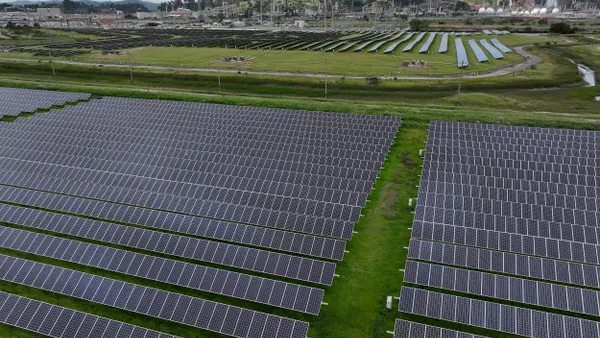When Manuel Pérez Dubuc first got involved in the energy storage space 14 years ago, the idea of developing 1 MW utility-scale projects — when lithium-ion batteries were essentially only used in cellphones — sounded crazy.
But at the same time, Dubuc — an electrical engineer, who spent most of his life in the field — fell in love with the concept. He was cognizant of the potential that the technology could offer, including the chance to open up a new dimension in the energy sector — the "holy grail for renewables becoming part of the grid 24/7."
Dubuc, who has been working with AES on and off for about two decades, took on the role of CEO of Fluence, a joint venture between Siemens and AES, in May, replacing former head Stephen Coughlin who had led the company since it was created in 2018. Dubuc had previously held stints heading a Chinese power company and working for AES' business in the Dominican Republic, and was on Fluence's board before taking over as CEO. In a statement announcing his appointment, he called it a "pivotal time" for Fluence, with opportunities to create a new generation of clean power systems centered around energy storage.
"I saw this opportunity to become the CEO of Fluence and try to take this company to the next level," he told Utility Dive in a recent interview.
Dubuc has high expectations for the energy storage industry over the next decade. Addressing climate change and the shift to renewables have become a social and technological "megatrend," he said, and simultaneously, people are understanding the huge potential of storage along with it. At the same time, lithium-ion battery prices have dropped almost 90% in the last decade, he said, making storage a compelling option to link with wind and solar.
Other stakeholders agree.
"I think this will be a really incredible decade of market acceleration, and for many types of storage," said Alex Morris, executive director of the California Energy Storage Alliance.
Morris expects to see accelerated deployments of different battery types, as well as more diversity in the broad storage fleet as different solutions — like compressed air, hydrogen and liquid air — come onto the electric system, whether in the form of pilots or actual commercial deployments.
"I'm thinking by the end of the decade, we'll see many commercial deployments of these different technologies," he said.
The accelerating growth of renewables is a testament to what's going to happen in the storage business over the next decade, said Tom Kuhn, president of the Edison Electric Institute, at the Energy Storage Association's Energy Storage Annual Conference & Expo this week.
"We see exponential growth there — we already see it happening — and it's not just going to be on the renewable side, not just on the generation side, but also we see it happening on the transmission and distribution side as well," Kuhn added.
John Hewa, president and CEO of Rappahannock Electric Cooperative, concurred that the adoption of renewables will drive large volumes of energy storage — which will in turn improve the rate at which the industry brings costs down.
"That's really going to help us move forward and justify, from a benefit-cost perspective, how we can complement renewables with increased storage," Hewa said at the conference.
Growing in the midst of the pandemic
Dubuc took on his role at Fluence in the midst of a global pandemic, which he noted has put a lot of businesses in a very dire situation.
"I think we were very lucky that, being such an important element of the grid, which is critical infrastructure, we haven't been affected at all. On the contrary, everybody's looking at us for whatever you need to keep the lights on," he said, adding, "Electricity is a vital element for all hospitals and supply chains and services."
On a more operational level, the company has been working remotely and put in place protocols for construction sites around the world, but has not seen any hit to productivity, Dubuc said.
Dubuc doesn't expect the pandemic to affect the broader growth trajectory of the storage sector, given the big push to accelerate renewables across the world. If anything, he expects a bigger push toward clean energy policies after the pandemic, which will require Fluence to gear up for an expected significant increase in demand.
"But that's good, because the more that you deploy our solutions in the market, the higher the volume, the lower the costs — so overall, it's going to be better for everyone. It's a win-win," he added.
'We really need to prepare ourselves for scaling up the company'
As of June, Fluence had deployed or been awarded 2.1 GW of storage in 22 countries. That month, it launched its newest storage technology "stack" — a modular system equipped with machine learning — which had already lined up 800 MW, 2,300 MWh worth of orders around the world. And in the midst of the COVID-19 pandemic, which has led many companies to begin laying off staff, Fluence is continuing to hire and grow, Dubuc said, working on 73 projects simultaneously across the world.
"We really need to prepare ourselves for scaling up the company, and I think that's my role — coming to Fluence and using my experience managing very big companies and high growth endeavors or initiatives … so we can really scale up and prepare ourselves to become 10 times bigger," he said.
The company has ambitious plans for the next few years — by 2021, it expects to have around 2 GW of customer projects operational, with around 3 GW to be operational by 2022. The challenge now, said Dubuc, is figuring out how to expand its market share with this pace of growth.
"It's true that there's a lot of competition [in the storage space] — but at the same time, we have seen a lot of consolidation," Dubuc said, noting that in the last four to five years, many players either left the industry or were acquired.
"The competition is not really getting the traction that they need in order to stay in business," he said, adding that Fluence's leading position comes from the economies of scale, as well as the amount of software and applications the company is delivering.
On the regulatory front, unlike wind and solar, which were initially deployed with a lot of regulatory support and subsidies, "we have never had any incentives whatsoever — neither taxes nor subsidies," Dubuc said. "So it's a technology that is so powerful and so transformative that even without subsidies, it has been able to reduce the cost by 90%, to multiply our presence by 2,000 times, and to find new applications."
Some kind of federal or other incentive could really drive the technology to become widely used, he said — "but it's not something that we are relying on, and we haven't been relying on that for a decade."















